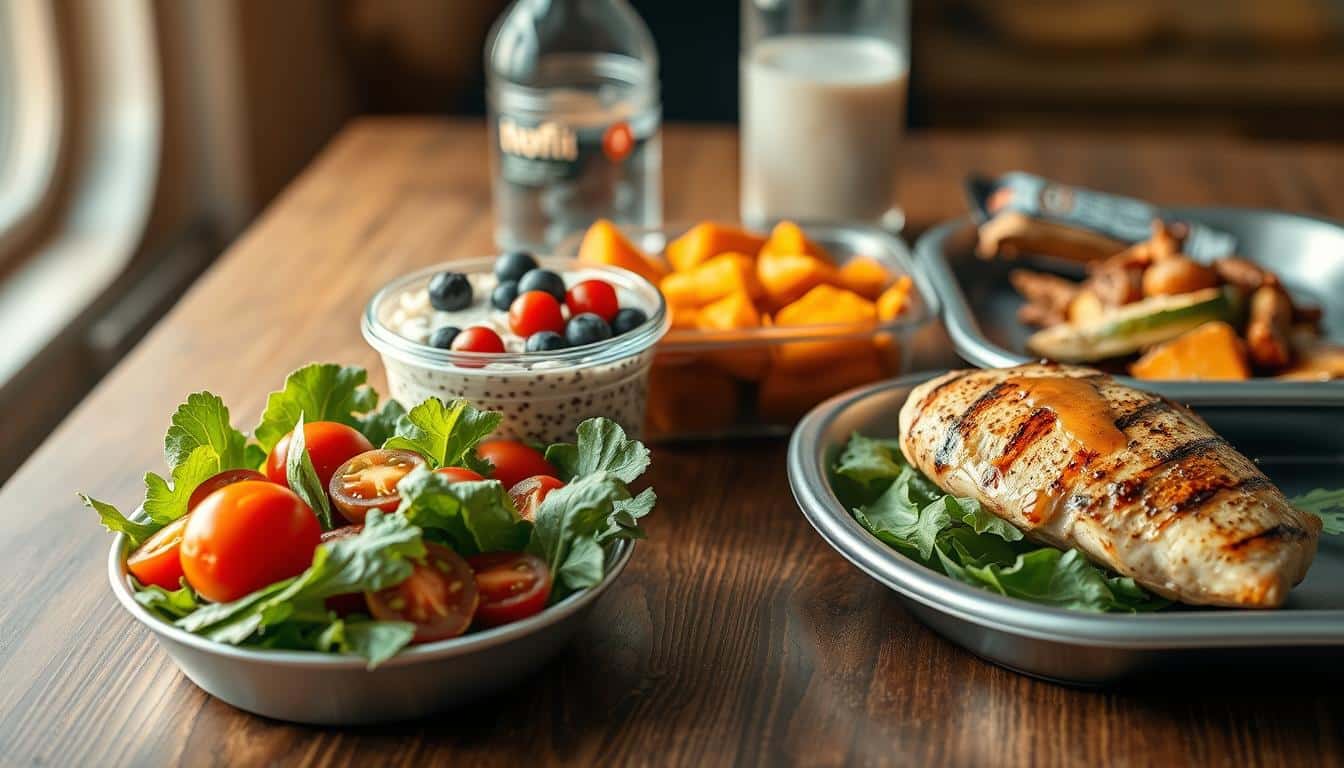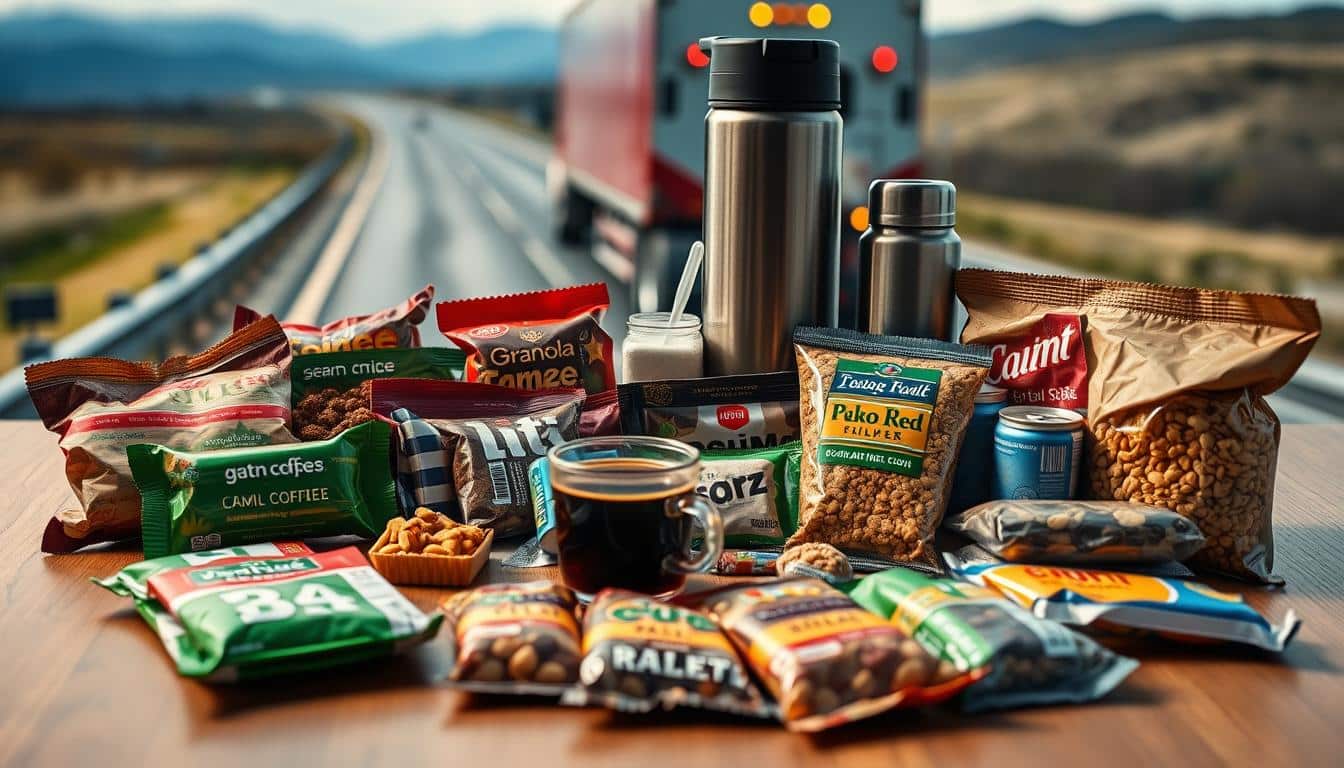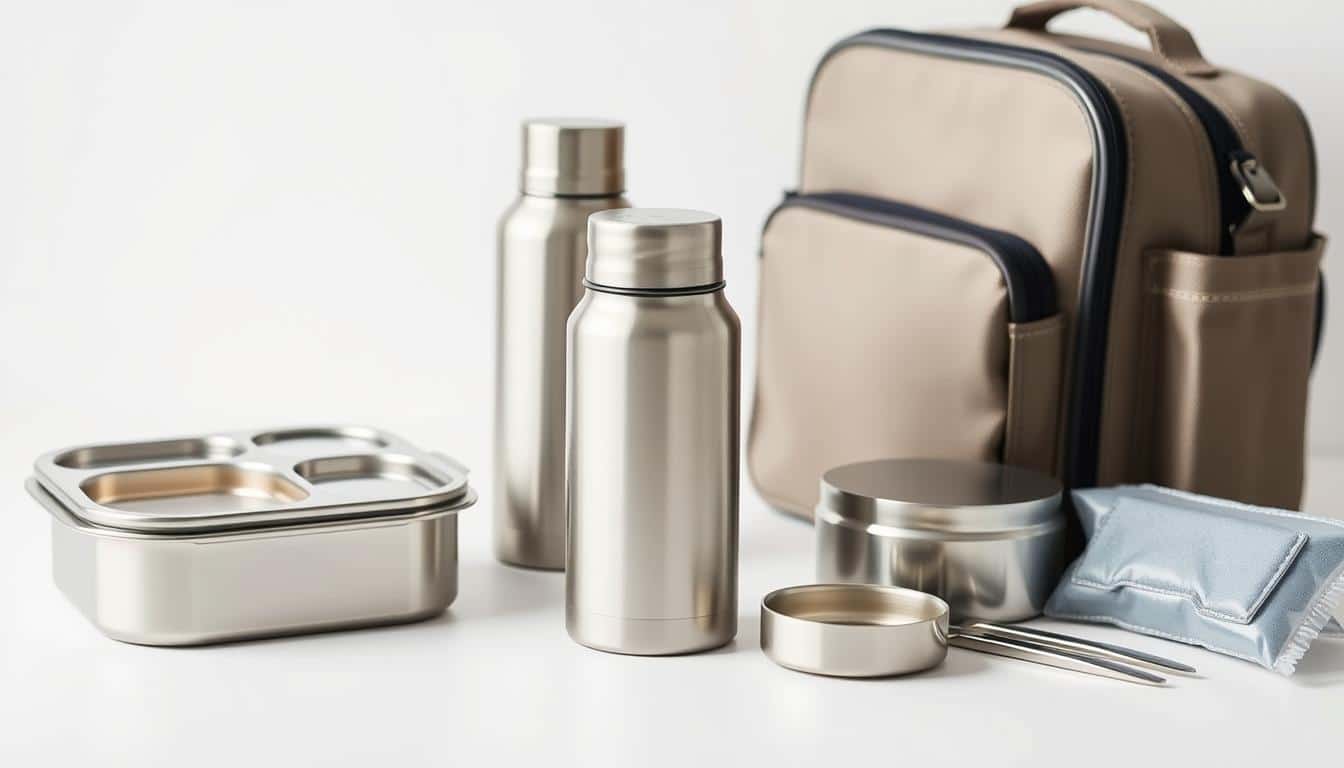Setting up a camp kitchen can really enhance your outdoor experience. This guide is for U.S. campers. It will help you pick portable cooking gear for any adventure.
We tested products from top brands like Lodge and Coleman in various places. Places like Sierra, Alaska, and the Pacific Northwest. We looked at cooking performance, durability, and ease of use.
This guide will give you clear advice on picking the best camping gear. You’ll learn about cookware, stoves, and even coffee systems. Our tips are based on tests, so you can trust your gear outdoors.
Why investing in quality camp kitchen gear matters
Good camp kitchen gear makes a trip way better. It makes things safe, fast, and helps save money over time. Think about how well each item works at camp and on the road.
Health and safety benefits
The Thermoworks ThermoPop 2 thermometer checks if food is cooked safely. It works fast and checks the temperature right. This cuts down on getting sick from food.
Using Grill Armor gloves and OXO Good Grips 16″ tongs lowers the chance of burns. These tools protect you when cooking with high heat.
Keeping food cold is key. Oyster Tempo and Yeti coolers keep things fresh. This keeps bacteria away and stops animals from coming close.
Use Dr. Bronner’s soap and clean away from streams. This keeps the camping area safe. It also follows Leave No Trace rules.
Save time and reduce cleanup at camp
Cookware that’s easy to clean saves time. GSI Pinnacle and MSR Fusion sets make cleaning quicker.
Miir carafes and Aeropress XL make mornings easier. They help serve drinks quickly and lessen washing up.
Collapsible items and nesting kits limit mess. Drip EZ Prep Tub and GSI pots help keep things tidy and reduce cleaning.
Organized gear speeds up setting up camp. Cleanly stored gear makes camp life simpler and less messy.
Longevity and value: when to choose premium vs budget
Durable gear, like Snow Peak cookware, VSSL Java grinders, and Oyster Tempo coolers, is better for those who camp a lot. They last longer and work better.
Cheaper gear, like Lodge cast iron and GSI Glacier sets, is good for those who camp less often. They offer good quality for less money and are easier to keep up.
Pick the right material for your camping style. Ultralight titanium is great for backpacking. Cast iron is good for car camping where carrying less weight is okay.
Field tests reveal pros and cons. A Miir carafe is easy to clean but might leak. VSSL grinders grind well but are heavy. Think about these when picking gear.
Portable cooking gear essentials for every car camping trip
Car camping requires gear that’s both light and effective. Choose items that can feed a group but still fit in your trunk. Here are some top picks and actual products to create a solid camping kit.
Cookware choices
- Cast iron options, like the Lodge Pre-Seasoned Cast Iron Skillet, are perfect for searing and stews. But they’re heavy, so they’re best for when you’re not moving much.
- Hard-anodized nonstick cookware, such as the GSI Pinnacle Camper, heats quickly and is easy to clean. Just remember to avoid metal utensils to protect the surface.
- Titanium gear, like the Snow Peak Ti-Mini Solo Combo, is ultra-light. It’s great for solo travelers but not for big group meals.
Stoves and grills
- Coleman two-burner stoves are perfect for car camping. They offer good heat control for cooking various dishes.
- Portable gas grills, like the Weber Q 1200, are great for high-heat cooking in a small space. It’s compact but powerful.
- For charcoal lovers, the Masterbuilt portable grill and Solo Stove Bonfire with a grill top provide great options for open-flame cooking.
Cutlery, utensils, and prep tools
- The Opinel Nomad Cooking Kit is a compact choice. It has a folding peeler and a small cutting board, among other tools.
- New West KnifeWorks offers a durable outdoor chef knife for tough prep jobs. It’s made to last in field conditions.
- Sea to Summit makes a compact kitchen knife perfect for small spaces. It’s light and easy to handle.
- Important utensils include durable tongs, spatulas, a whisk, and folding sporks. A simple checklist ensures you have everything needed for camp cooking.
When packing, focus on sturdy items that fit your menu and group size. A careful selection of cooking gear simplifies meals and enhances the camping experience.
Best cookware types and when to use them
Picking the right camp cookware impacts both your meals and your adventure. Each material and design offers unique benefits and limitations. Here’s a quick guide on three top choices to help align your gear with your meal plans, load, and trip duration.
Cast iron for searing and lasting use
Cast iron excels at keeping heat for perfect searing of steaks and bacon. A Lodge cast iron skillet offers consistent warmth, ensuring a solid sear. Lodge’s Pre-Seasoned 8.25″ skillet is tough and ideal for campfires, although it’s heavy.
Opt for cast iron if weight isn’t an issue and you crave versatility, like skillet dishes or Dutch oven meals. Be ready to maintain its seasoning and tolerate its heaviness in your camping or basecamp equipment.
Hard-anodized aluminum and easy-clean nonstick
Hard anodized cookware gets water boiling quickly, conserving fuel. Options like the GSI Pinnacle series and MSR Fusion Ceramic sets demonstrate efficient, light designs. Their rapid heating and nonstick properties make cleanup easier.
Pick hard anodized pieces for trips with family or groups where easy meals and cleanup are priorities. Avoid metal utensils to keep the nonstick coating safe and follow care instructions to keep them lasting longer.
Titanium for ultralight backpacking
When minimizing weight is vital, titanium cookware stands out. Products like Snow Peak’s Ti-Mini offer incredible lightness, compact storage, and resistance to rust. They’re designed to be space-efficient and include cups with measurements for drinks and meals.
Use titanium on solo journeys or when keeping gear light is paramount. Though prioritizing weight savings, prepare for smaller cooking volumes and a higher price compared to aluminum or steel options.
- Cast iron camping skillet — best for searing, heat retention, and long-term durability at basecamp.
- Hard anodized cookware — best for fuel efficiency, ease of cleaning, and family-sized modular sets.
- Titanium backpacking cookware — best for ultralight packing and solo trips where weight is critical.
Top portable stoves and grills for outdoor cooking
Picking the right outdoor cooking gear can make camp meals a breeze. This section talks about great choices for car camping, offering high-heat searing with portable gas grills, or systems that work with charcoal or campfires. It also gives brief notes on their differences, weight, and how to stay safe while using them.
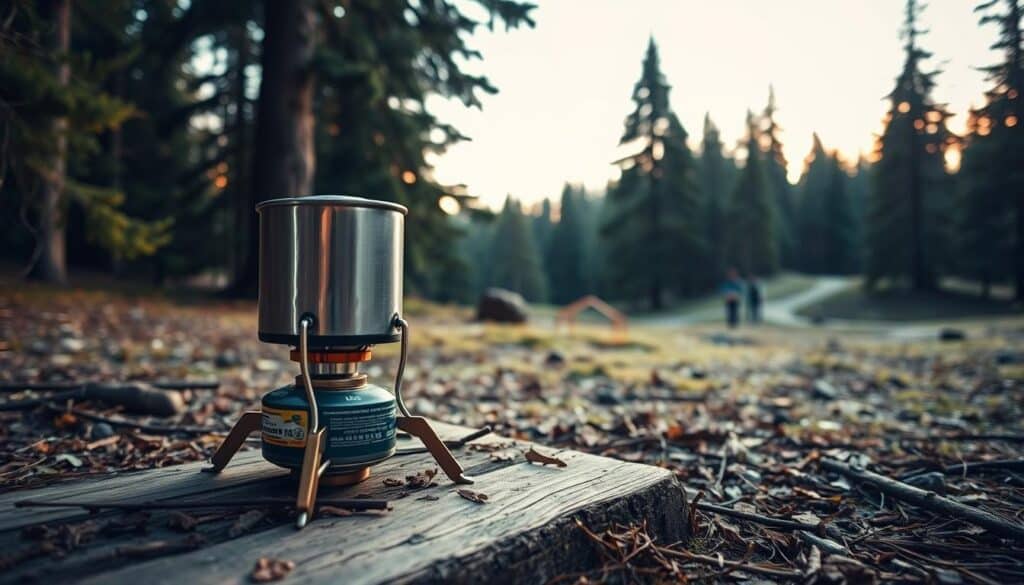
Car camping groups often go for a two-burner camping stove. These Coleman two-burner stoves are around 11–12 lbs. They give off about 10,000 BTU per burner. They are easy to light with autoignition. Plus, they’re compact enough to fit in a car trunk. They heat food fast, are easier to clean than a fire, and work well for cooking with several pots.
When choosing a two-burner stove, look for good wind protection and a flat surface for your pans. There are lighter models but they might not be as stable or powerful. For families, these stoves make cooking simple and hassle-free due to their reliable heat and small size.
Those who love grilling should check out the Weber Q 1200. It weighs about 31 lbs and offers 8,500 BTU. It’s heavier than some options but far lighter than a full-sized grill. Its cast-iron grate is perfect for searing. The Weber Q 1200 is great for car campers wanting grill results without a big grill.
Other gas grill options are compact and easy to store. They hold small propane canisters and come with prep trays and built-in storage. These features help when you have limited space but still want quick setup for short trips.
For lovers of charcoal flavors, there are portable charcoal grills. Options vary from small 200 sq in models to ones you can use over a campfire. Portable charcoal grills by Masterbuilt give a genuine smoke taste but might need more effort for ash management. A charcoal grill offers a rich flavor for both grilling and smoking.
A stainless steel fire pit with a cast-iron grill top is another choice. The Solo Stove Bonfire with a Solo Cast Iron Grill Top lets you cook over a clean, controlled fire. It’s great for groups wanting heat and grill capabilities in one.
There are pros and cons to each option. Stoves heat up fast and boil water quickly. Charcoal and fire setups need more time to heat up and involve cleaning ash later. Always follow the campsite rules, keep cooking spots away from tents, and use protective gloves and tools to avoid burns.
- Coleman two-burner camp stoves: reliable for group cooking, easy setup.
- Weber Q 1200: strong searing, solid grill performance for car campers.
- Masterbuilt-style charcoal units and Solo Stove combos: best for authentic charcoal flavor.
Essential drink and coffee gear for mornings on the trail
Mornings at camp are great with the right drink gear. Choose tools that fit your routine, group size, and trip style. Compact pieces are enough for car camping, vanlife, or basecamp.
For keeping drinks hot, go for stainless-steel vacuum gear. The Miir New Standard Carafe holds 33 oz and is easy to clean. It keeps coffee hot for two hours.
Zojirushi bottles keep drinks hot for a long time, perfect for cold mornings. Simple Modern Provision jars are great for hot soups or stews after hiking.
Portable grinders and brewers
Grinding fresh beans makes camp coffee great. The VSSL Java G25 is lightweight and has many grind settings. It’s good for car camping and vanlife.
The Aeropress XL works well for couples and small groups. It’s easy to use and clean. Use the 1Zpresso JX and Timemore C2 Max for quick and reliable grinding.
Single-serve and group coffee options
- For single-serve: The Kalita Wave Dripper 155 and Vietnamese phin filters are perfect for strong coffee outdoors.
- For groups: Aeropress XL and Fellow Clara French Press make larger pots easily. A stainless French Press keeps coffee hot longer than glass.
- For emergencies and ultralight trips: High-quality instant coffee like Intelligentsia Black Cat or Ruby Coffee Roasters is tasty and light.
Packing tips
- Keep beans fresh in a small, airtight container.
- Use a lightweight insulated carafe at camp to share hot coffee.
- Choose a grinder that fits your trip: VSSL for car trips and compact grinders for hiking.
Picking the right gear can make mornings special. Balance the gear’s weight, durability, and quality for your camping style. The right camping coffee gear, including a portable grinder and insulated carafe, will improve your mornings on the trail.
Compact cookware sets and mess kits for different trip styles
Choosing the right compact cookware can make or break a trip. How well it packs, saves fuel, and meets your cooking needs is key. Here you’ll find options for light solo trips, adventures for two, and group camping by the car.
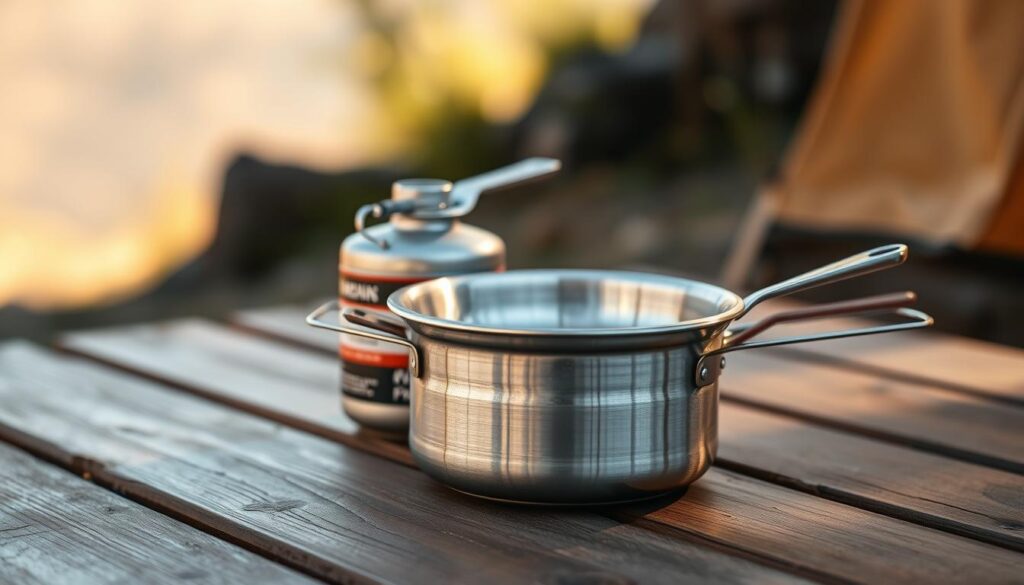
-
Ultralight solo sets
The Snow Peak Ti-Mini Solo Combo 2.0 is perfect for those wanting the lightest bag. It’s only 0.4 lb and fits a 30 oz pot and a 16 oz mug inside. Plus, it has foldable handles and space for a fuel canister, making it ideal for minimalists.
But there’s a downside. Its small size means you can’t cook big meals or sauté much. And, though titanium is pricier than aluminum, it lasts longer and is lighter.
-
Two-person backpacking kits
For duos watching their fuel usage, the GSI Outdoors Pinnacle Dualist HS is great. It weighs about 1.4 lb. Its pot heats water super fast, taking around 1 minute and 18 seconds. It comes with bowls, insulated mugs, and a strainer lid that all fit together.
It’s a cookset that’s efficient and easy to pack. The only drawback is, it’s not great for frying. But it’s fuel-efficient, saving you time and resources on longer trips.
-
Basecamp and family sets for car camping
When car camping, go for bigger sets that aren’t heavy. The GSI Pinnacle Camper is about 3.7 lb. It has everything for four: nonstick pots, a frypan, mugs, bowls, and plates. It makes serving and cleaning up easy.
For more robust cooking, add the Lodge 3.2 Qt Cast Iron Combo Cooker. Weighing about 12.3 lb, it’s great for searing and slow cooking, lifting your camp food game.
Combine one of these sets with a strong stove or grill. It’s perfect for cooking big meals and enjoying food with everyone.
Storage, prep, and organization solutions to streamline camp cooking
Smart storage in your camp kitchen keeps everything ready for use. It also avoids a messy campsite. These small storage systems save space, make setup quicker, and help keep wildlife away by storing food the right way. Here are some gadgets and tips to help cooks work more efficiently and keep the food safe.
- Collapsible prep tubs and marination stations: The Drip EZ Prep Tub is a collapsible tub ideal for marinating meat or preparing veggies. It adjusts to various heights with silicone walls and has a cutting board base and a lid that snaps shut. Its feet stay put on uneven surfaces. Though light, its sides may compress under heavy loads.
- Nesting camp bowls and insulated food storage: The Yeti Three Course Bowl Set includes bowls that fit together to save space. They use insulation to keep meals hot or cold. Their shape saves space, while their durable build lasts. However, lids may not lock tightly, and steam vents might leak, so extra sealing is needed for liquids.
- Kitchen organizers and tool rolls: A good kitchen organizer adds neatness. Radius Outfitters offers a durable one that shields your tools and arranges utensils neatly. The Opinel Nomad Cooking Kit includes essentials like a peeler and a small cutting board in a compact roll. These reduce the need to search for items and make serving meals faster.
Practical packing tips:
- Make a camp box with your eating and cooking essentials, keeping it away from perishable items. This makes setting up easier.
- A collapsible prep tub is great for marinating and washing. Collapse it for easy transport, saving space in your vehicle.
- Keep perishables in a sturdy cooler, like one made of double-wall aluminum or a high-performance soft cooler. Store coolers indoors overnight if it’s allowed, to prevent wildlife visits.
- Mark your nested bowls and lids for quick access. Keep them together to avoid messes at washing stations.
Always stick to campground rules for storing and throwing away food. Using the right camp kitchen storage and gadgets can reduce cleanup time. This lets you enjoy more of the outdoors.
Cutlery, knives, and prep tools recommended for camp kitchens
Choose smart cutlery to make cooking at camp faster and safer. Include folding sets, a solid chef knife, and a small kitchen knife for cramped spaces. Don’t forget a few small prep tools and something to sharpen the knives outdoors.
-
Folding, travel-friendly kit: The Opinel Nomad kit is perfect for light tasks. It comes with a folding peeler, a knife with a corkscrew, a serrated knife, a small board, and a cloth. Everything stays together in a roll-up case, and the beechwood handles are stylish. The kit is handy but can be too small for heavy jobs and costs more than single tools.
-
Heavy-duty chef and tactical option: Choose a tactical chef’s knife for big jobs. The New West KnifeWorks Tactical Outdoor Chef offers a long blade, a comfortable handle, and balanced weight. It’s great for slicing, chopping, and outdoor cooking. But, it’s pricier and needs careful sharpening due to its serrated parts.
-
Compact, reliable camp knife: The Sea to Summit Detour knife is ideal for tight spots. Its short blade and solid handle work well on small boards. It’s lightweight and reliable for common camp dishes. It works well alongside bigger knives for preparing complete meals.
Complete your collection with a small board, tongs, a spatula for fish, and a little whisk. The Gerber Compleat board kit and long OXO Good Grips tongs help cook without mess. Serrated foldable tools are useful for bread and veggies with tough skins.
Care for your tools. Bring a travel sharpener or a detachable sharpener. Pick stainless steel for easy-care near water and high-carbon steel for longer-lasting sharpness if you can avoid rust. Looking after them means your camping knives, Opinel Nomad kit, tactical chef knife, and Sea to Summit Detour knife will last longer.
Accessories that improve safety, convenience, and performance
Smart camp cooking gadgets make meals safer and easier. They protect your hands, speed up tasks, and ensure food safety. Choose items that are compact, stackable, and versatile for the ideal camp kitchen.
Heat-resistant gloves and long tongs for safe handling
Using grill gloves lets you handle hot cookware safely. Grill Armor Gloves Extreme Heat-Resistant are made with special fibers and have silicone grips. They are 12″ long, offering extra protection for your wrists near fire.
Combine these gloves with long tongs for a safer cooking experience. OXO Good Grips 16″ Locking Tongs are great for cooking. They have a metal body and rubber grips, making cooking and serving easy while protecting your hands.
Thermometers and food-safety tools (ThermoPop 2)
Getting the right temperature prevents undercooking and reduces the risk of illness. Thermoworks ThermoPop 2 is quick and accurate, perfect for trail cooking. It has a rotating screen and backlight for easy reading any time of day.
Bring a small probe thermometer to ensure food safety. Pack it with extra batteries in a tiny pouch so it’s always ready.
Cleaning essentials: biodegradable soap and reusable dishcloths
Choose cleaning supplies that are eco-friendly and effective. Dr. Bronner’s Pure-Castile Liquid Soap is a good choice for dishes and personal use, just keep it away from direct water sources.
Swedish-style dishcloths are quick drying and efficient for scrubbing. Use a separate tub for washing to keep things organized and manage wastewater better.
- Design a dishwashing workflow: rinse, wash, rinse, sanitize in hot water, then pack wastewater out following park rules.
- Include pot grippers, folding utensils, insulated mugs, and storage sacks for a compact kit that cuts fumbling and saves time.
How to choose the right setup for your adventure and budget
Choosing the right gear starts with your trip’s plan. This guide helps pick camping gear based on your travel style, cooking habits, and how much gear you want to bring. Think about what’s most important to you, then explore special equipment.
Match gear to trip type
- Car camping / basecamp: go for sturdy and diverse gear. Items like Lodge cast iron, GSI Pinnacle Camper cookware, Coleman two-burner stoves, Weber Q 1200 grills and Yeti coolers are great when weight doesn’t matter.
- Backpacking / ultralight: focus on things that are light and pack small. Snow Peak Ti-Mini, MSR Fusion Ceramic pans, and GSI Pinnacle Dualist HS are top picks for quick heating and little space.
- Day trips / picnics: opt for gear that’s easy to carry and set up quickly. Solo Stove portable pits, compact grills, collapsible Drip EZ tubs, and Miir camp cups are good choices.
Prioritize by cooking style
- Grilling: choose a Weber Q 1200 or a portable Masterbuilt charcoal grill for big meals and easy cleaning.
- Stove-top cooking: Coleman two-burner and GSI Dualist HS are best for quick boiling and cooking different dishes at once.
- Campfire baking: pick a Lodge Dutch oven or combo cooker and a Solo Stove Bonfire for steady heat and tasty campfire meals.
Balancing weight, packability, durability, and cost
Think about how easy gear is to carry versus how long it lasts. Look at how well each item cooks first, then consider its features, how easy it is to use, and its durability over time.
- Suggested metric mix: Cooking Performance 35%, Features 15%, Ease of Use 15%, Durability 15%, Packability 10%, Weight 10%.
- Example outcomes: GSI Pinnacle Dualist HS is great for efficient boiling and saving fuel on trips for two. Snow Peak Ti-Mini wins for being super light and easy to pack. Lodge products are top for lasting a long time but are heavier and bulkier.
Budget guidance and buying order
Begin with the basics: a reliable skillet, a good stove, a sharp knife, a thermos, and a folding tub. These are the most valuable items for any trip.
Consider special items only if you camp a lot and need specific features. Always compare specs, read reviews, and resist buying on a whim.
Conclusion
Smart investments in portable cooking gear make outdoor meals better. With a ThermoWorks ThermoPop 2, meals are safer. Nonstick sets from GSI Pinnacle or a seasoned Lodge cast iron make cleaning up quicker. Choosing the right gear means considering your cooking style and trip type.
Begin with the basics, then expand your collection. Car campers should go for tough cast iron or big nonstick sets and a sturdy two-burner stove like Coleman. Backpackers should pick light items like the Snow Peak Ti-Mini or compact hard-anodized cookware. Also, don’t forget about coffee tools—Miir carafes, VSSL Java G25, or an Aeropress XL—and sharp cutlery from Opinel Nomad or New West KnifeWorks to get the job done.
Also, think of how you’ll store and prepare. The Drip EZ Prep Tub, Yeti Three Course Bowls, and Radius Outfitters organizers make things easier and neater. Look at testers’ findings on boiling times, material strength, and use in the field to find the best mix of weight, durability, and price. This summary shows that careful choices lead to meals outdoors that are safer, more delicious, and simpler to make.
FAQ
What cookware should I choose for car camping vs backpacking?
How do I balance weight, durability, and cost when buying camp kitchen gear?
Are hard‑anodized nonstick pots safe and worth it for camp use?
What stove or grill is best for feeding a group at camp?
How important is a food thermometer at camp?
What coffee and drink gear should I bring for mornings outdoors?
How do I keep food safe and prevent wildlife encounters?
Which knives and prep tools are best for a compact camp kitchen?
What collapsible or nesting gear speeds prep and cleanup?
Can I use cast iron over a Solo Stove or campfire safely?
How do I clean dishes and manage wastewater at primitive sites?
What should I prioritize when building a basic camp kitchen on a budget?
Are premium items like Oyster Tempo coolers, New West knives, or Snow Peak titanium worth the investment?
What are practical packing tips to keep my camp kitchen organized?
How do testing metrics influence product choices for different trip styles?
Content created with the help of Artificial Intelligence.

